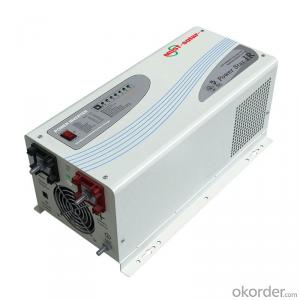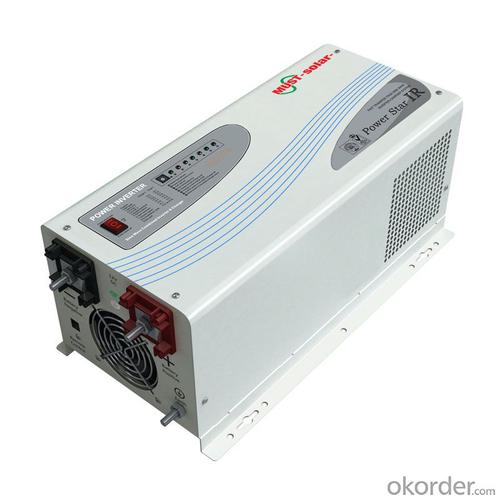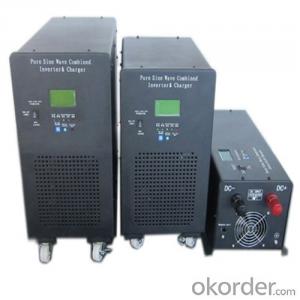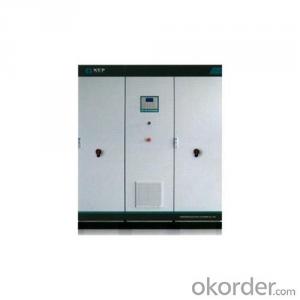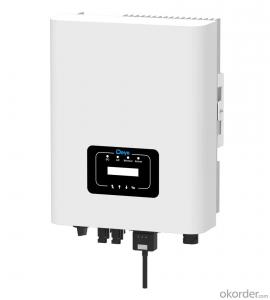T.A. Solar Inverter - PWM/MPPT Solar Inverter 1000W - 6000W Reliable
- Loading Port:
- China main port
- Payment Terms:
- TT OR LC
- Min Order Qty:
- 100 pc
- Supply Capability:
- 1000 pc/month
OKorder Service Pledge
OKorder Financial Service
You Might Also Like
Pwm/mppt Solar Inverter1000W -6000W Reliable
Features :
1. High overload ability of our EP3200 charger is up to 300% rated power
2. EP3200 pure sine wave inverter adopts low quiescent current, and power saver mode to reduce power consumption to 3W . It can extract max. power from various batteries with different protections, and low voltage trip can be selected (10V/10.5V/11V).
3. Uses PFC (power factor correction) for charger, which has less power consumption than conventional units.
4. It has 10s delay before transfer when AC resumes, and overload protection when our APC pure sine wave inverter equips with generator.
5. 10ms typical transfer time between battery and AC, which guarantees power continuity of EP3200 charger. Uses selectable input AC voltage (185-265V or 155-255V) for different kinds of loads.
Specification:
| Rated Capacity | 4000W | 5000W | 6000W | |
| Efficiency | >90% | |||
| Input | ||||
| Model | 120v Models | 230v Models | ||
| Nominal Voltage | 100V/110V/115V/120VSelectable | 200V/220V/230V/240V Selectable | ||
| Output | ||||
| Rated Power | 4000W | 5000W | 6000W | |
| Output Voltage | 100V/110V/115V/120V Selectable | 200V/220V/230V/240V Selectable | ||
| Voltage Waveform | Pure Sine Wave | |||
| Crest Factor | 3:1 | |||
| Transfer Time | Transfer Time : AC To DC : 10ms (Typical) Transfer Time : DC To AC : 10ms(Typical ) | |||
| Max Bypass Overload Current | 30A | |||
| Input | ||||
| Nominal Voltage | DC24V/48V | DC48V | DC48V | |
| Over Current Protection | By Re-Settable Over Current Protector | |||
| Output | ||||
| Regulation (Nominal) | ±10% Typical Of Nominal Voltage | |||
| Nominal Input Voltage | 230Vac | |||
| Input Voltage Range | 185-265Vac | |||
| Nominal Output Voltage | According To The Battery Type | |||
| Nominal Charge Current | 30Amp-70Amp | |||
| Battery Type | Lead-Acid 12Ah ~ 250Ah | |||
| Typical Backup Time | No Limit | |||
| Charging Method | Smart Pulse Charging With Two Charging Modes: Quick Charging When Battery Is Not Fully Charged, Trickle Charging When Battery Is 90% Fully Charged. | |||
| Average Charging Current | 65A/35A | 70A/40A | 50A | |
| Battery Voltage options | ||||
| Options 7 | Battery low trip to bypass 11v , high trip to battery 14v | |||
| Options 8 | Battery low trip to bypass 10.5v , high trip to battery 13.5v | |||
| Options 9 | Battery low trip to bypass 10v , high trip to battery 13v | |||
| Communications & Management | ||||
| Control Panel | LCD/LED Option | |||
| Audible Alarm | Alarm On Battery: Low Battery & Battery Over Voltage Alarm On Abnormal Operation: Over Load, Short-Circuit, & Over Heat | |||
| Environment And Safe | ||||
| Operating Temperature | 0℃ To 40℃ (32℉ To 104℉) | |||
| Transit/Storage Temperature | -15℃ To 60℃ | |||
| Audible Noise | 60 Dba Max at 1m | |||
| Quality Control System | ISO 9001,FCC,CE | |||
| Physical | ||||
| Dimensions: (H×D×W) | 755*320*310mm | |||
| G.W (Kg) | 37.5 | 47.5 | 47.5 | |
| Packing | Export Carton For Each Unit Per Carton | |||

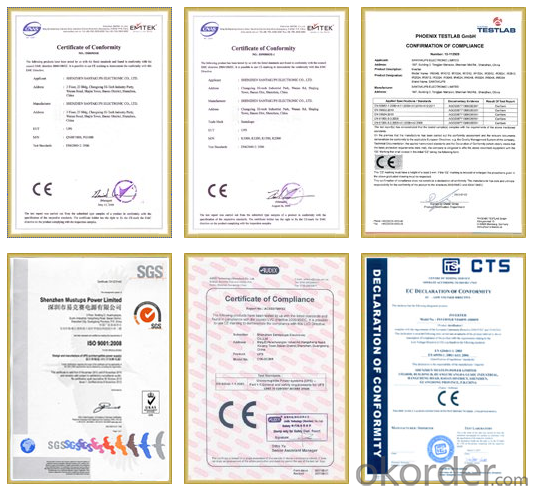

Warrenty
provides a 1~3 year limited warranty (“Warranty”) against defects in materials and workmanship for its Uninterruptible power supply, Power inverter/chargers, Solar charge controllers, Battery Products (“Product”).
The term of this Warranty begins on the Product(s) initial purchase date, or the date of receipt of the Product(s) by the end user, whichever is later. This must be indicated on the invoice, bill of sale, and/or warranty registration card submitted to MUST-Solar. This Warranty applies to the original MUST-Solar Product purchaser, and is transferable only if the Product remains installed in the original use location.
FAQ
1. How fast will my system respond to a power outage?
Our solar inverters typically transfer to battery power in less than 16 milliseconds (less than 1/50th of a second).
2. What kind of batteries do the systems include?
Our solar backup electric systems use special high-quality electric storage batteries.
3. How do I install my system?
A solar backup inverter is connected to a home electric system , we will supply detailed installation manual and videos for our customers .
- Q: What is the role of anti-islanding protection in a solar inverter?
- The role of anti-islanding protection in a solar inverter is to ensure the safety of utility workers and prevent damage to the electrical grid during a power outage. It detects when the grid goes down and immediately disconnects the solar inverter from the grid, isolating it to prevent any power from flowing back into the grid. This prevents the phenomenon known as islanding, where the solar system continues to generate power and creates a potential danger for utility workers who may be working on the lines believing they are de-energized. By disconnecting from the grid, anti-islanding protection helps maintain the stability and integrity of the electrical system.
- Q: Can a solar inverter be used in harsh environmental conditions?
- Yes, solar inverters are designed to withstand harsh environmental conditions such as extreme temperatures, high humidity, and exposure to dust, dirt, and corrosive elements. They are built with robust materials and undergo rigorous testing to ensure their durability and reliability in challenging environments. Additionally, some solar inverters come with IP65 or higher ratings, indicating their resistance to water and dust ingress, making them suitable for installation in outdoor and harsh conditions.
- Q: Can a solar inverter work without sunlight?
- No, a solar inverter cannot work without sunlight as it relies on solar energy to convert the direct current (DC) produced by solar panels into alternating current (AC) for use in homes and businesses.
- Q: Can a solar inverter be used in areas with high altitude and low temperature conditions?
- Areas with high altitude and low temperature conditions can indeed use a solar inverter. However, it is important to take certain factors into account when choosing one for such conditions. The efficiency of a solar inverter can be affected by high altitude, as the reduced air density and oxygen levels can lead to a decrease in power output from the solar panels. Therefore, it is vital to select an inverter that is specifically designed to function at high altitudes. These inverters come equipped with features like advanced cooling systems and improved power electronics to ensure optimal performance in such environments. Similarly, low temperature conditions can also impact the efficiency of a solar inverter. Cold temperatures can negatively affect the internal components of the inverter and overall performance. To overcome this challenge, it is recommended to choose an inverter that is designed to operate in low-temperature environments. These inverters typically include features such as internal heaters and temperature sensors to maintain optimal performance even in freezing temperatures. Furthermore, it is advisable to seek guidance from a professional solar installer or manufacturer who can assist in selecting the most suitable solar inverter for high altitude and low-temperature conditions. They can consider factors like local climate, altitude, and specific installation requirements to ensure that the system is designed to withstand and perform optimally in these demanding conditions.
- Q: What is the maximum power capacity that a solar inverter can handle?
- The maximum power capacity that a solar inverter can handle varies depending on the specific model and brand. However, modern solar inverters can typically handle power capacities ranging from a few hundred watts to several megawatts.
- Q: How does the temperature affect the performance of a solar inverter?
- The temperature affects the performance of a solar inverter by influencing its efficiency and power output. Higher temperatures can cause the inverter to operate less efficiently, resulting in a decrease in its overall performance. This is because the semiconductor components in the inverter may experience increased resistance, leading to more power losses and reduced conversion efficiency. Additionally, excessive heat can also lead to thermal stress and component degradation, potentially impacting the long-term reliability and lifespan of the inverter.
- Q: Can a solar inverter be used with solar-powered remote sensing systems?
- Yes, a solar inverter can be used with solar-powered remote sensing systems. A solar inverter is an essential component of a solar power system that converts the direct current (DC) produced by solar panels into alternating current (AC) electricity, which can be used to power various devices and systems. This includes remote sensing systems, which rely on solar power to operate in remote or off-grid locations. The solar inverter ensures that the electricity generated by the solar panels is compatible with and can power the remote sensing system effectively.
- Q: How does MPPT improve the efficiency of a solar inverter?
- MPPT, or Maximum Power Point Tracking, improves the efficiency of a solar inverter by constantly adjusting the operating point of the solar panel to extract maximum power from the sunlight. It ensures that the solar panel operates at its maximum power point, regardless of changing weather conditions or variations in the solar irradiance. This optimization leads to higher energy conversion efficiency, maximizing the power output of the solar panel and ultimately increasing the overall efficiency of the solar inverter.
- Q: How does a solar inverter affect the overall system reliability?
- A solar inverter plays a crucial role in the overall system reliability of a solar power system. It converts the direct current (DC) generated by solar panels into alternating current (AC) that can be used to power homes or be fed back into the grid. By ensuring efficient and reliable conversion, a solar inverter helps optimize the system's performance and stability. It also incorporates various protection features like over-voltage and over-current protection to safeguard the system from potential damage. Therefore, a high-quality and well-maintained solar inverter positively impacts the overall reliability of the solar power system.
- Q: Can a solar inverter be used with different types of solar PV systems (roof-mounted, ground-mounted, etc.)?
- Different types of solar PV systems, such as roof-mounted, ground-mounted, and other variations, can utilize a solar inverter. The primary function of a solar inverter is to convert the direct current (DC) electricity produced by solar panels into alternating current (AC) electricity. This converted electricity can be used to power appliances and can also be fed into the electrical grid. The conversion process remains consistent regardless of the type of PV system being used. However, it's crucial to consider that the solar inverter's requirements and specifications may differ depending on the type of PV system. Different PV systems may have varying voltage and power outputs, which may necessitate specific inverter models capable of handling these requirements. For instance, ground-mounted solar systems may have larger arrays and higher power outputs than roof-mounted systems, requiring a different type of inverter. Hence, while a solar inverter can generally be used with various types of solar PV systems, it is essential to select an inverter that is compatible with the specific system's voltage, power output, and other technical specifications. It is always advisable to consult with a professional solar installer or technician to ensure the appropriate selection and installation of the solar inverter for your particular PV system.
Send your message to us
T.A. Solar Inverter - PWM/MPPT Solar Inverter 1000W - 6000W Reliable
- Loading Port:
- China main port
- Payment Terms:
- TT OR LC
- Min Order Qty:
- 100 pc
- Supply Capability:
- 1000 pc/month
OKorder Service Pledge
OKorder Financial Service
Similar products
Hot products
Hot Searches
Related keywords
